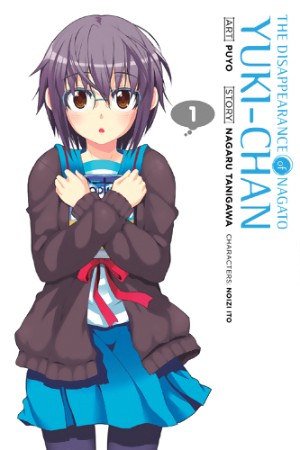By Nagaru Tanigawa and Puyo. Released in Japan as “Nagato Yuki-chan no Shoushitsu” by Kadokawa Shoten, serialization ongoing in the magazine Young Ace. Released in North America by Yen Press.
It is noted in the ads at the back of this volume shamelessly plugging the rest of the Haruhi franchise that in order to get maximum enjoyment from this work, you need to have read the original books, particularly the 4th novel, Disappearance (which was made into the Haruhi movie). I think this is quite accurate. Without the context of Haruhi, this seems a lot fluffier and pointless than it really is. Not that it isn’t already light as air – this is not a manga for those who seek the sci-fi adventures the original sometimes gives us. But knowing the original series as we do helps us to see what the artist is trying to achieve here by, in effect, changing Kyon’s decision in the 4th book. What if he’d stayed, and his memories were also rewritten? How would that universe have kept going?
As you might guess by the cover, the focus here is on Yuki, who is back to being the meek and shy but far more human Yuki we saw in that novel. Luckily, she’s not a complete wallflower. One sensible thing this manga does is start ‘in media res’, as it were, showing us several chapters of Yuki, Kyon and the other interacting before going back at the end and giving us a flashback as to how they met. This allows us to see a Yuki more comfortable with Kyon (although she’s still awkward around him) and even lets her have the occasional snarky line, although that’s mostly directed at Ryouko, who fires right back.
Ah yes, Ryouko. Fans have a tendency to influence other people’s creations, as many writers will tell you. Especially when this is a spinoff once-removed sort of series. The artist, Puyo, is also writing the Haruhi-chan gag mangas for Shonen Ace, which feature his own conceit of Ryouko coming back as an adorable plushie-like creature and basically losing every trace of evil in her. Likewise, fandom in Japan read the first Haruhi books (and Disappearance) and theorized that Yuki and Ryouko would be eating meals together and such before Haruhi showed up and Ryouko went insane. Combining the two, here we see Ryouko as a pure onee-san figure. She has a quick temper, and gets easily frustrated, especially by Yuki’s indecision, but this is a Ryouko who is not going to be stabbing Kyon anytime soon – a genuinely good-hearted character who really is Yuki’s best friend. It’s quite sweet.
There are a few flaws here, of course. As with Haruhi-chan, Puyo’s art can be highly variable, especially when he draws faces. Unlike Haruhi-chan, he isn’t allowed the luxury of going super-deformed all the time. So sometimes we see some very awkward poses and art. In addition, our hero Kyon, deprived of Haruhi’s antics giving him a cynical and sarcastic inner monologue, comes off as being a bit dull, the standard romantic lead for the shy girl who wins her heart by… well, by actually interacting with her. His sharpest moments are actually with Ryouko, who is trying to nudge the two leads together, much to Kyon’s clueless bafflement.
Even with the universe having been rewritten, and Kyon and Haruhi not meeting each other, she’s still not very far away. This time around, an older Haruhi gets Yuki to draw figures on the ground – this time sending out a message for Santa. It’s another example of what this series is trying to do. It’s taking the characters of the Haruhi franchise (including Haruhi, who will get more to do in the next volume) and putting them in situations that make you go ‘Awwwww’ and smile. If you enjoy the sharp, caustic comedy of the original franchise, it would be best to stick to that. As an AU alternative, though, this is simply cute as a button.


Pingback: MangaBlog — Viz speaks!